Enneagram Tri-Center 3-1-7: Heart Type 3, Gut Type 1, Head Type 7
The 3-1-7 Tri-Center
-

Your tri-center consists of your dominant type in each of the three centers of intelligence with a preferred ordering of the centers (types). The preferred ordering of the 3-1-7 is:
Heart Type: Type 3
-
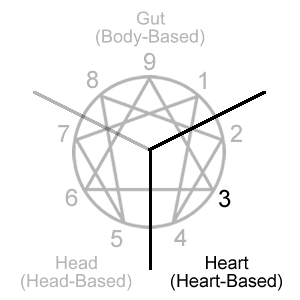
Type 3 is located in the 234 triad which is often described as the heart or heart-based center.
The heart types are focused on interpreting, expressing, and reacting to one’s own emotions or the emotions of others. More specifically, the heart center focuses on what's emotionally significant in the sense that emotions are an indication of how strongly a person resonates with or against something or someone.
This may involve being attentive to the emotional needs and desires of others, seeking emotional affirmation for oneself from others, and expressing one's own unique emotional impression of the world.
Type 3 often puts aside personal feelings that might get in the way of pursuing goals. Yet, they may also seek emotional affirmation or validation through recognition from others. Although accomplishments and the overcoming of challenges on their own can increase a sense of self-esteem, it can be hard to know how well they are performing without some external indicator, such as awards or recognition, to affirm their effort and value.
Type 3 Shame
The shame triad consists of types 2, 3, and 4. Shame for these types involves the heart center. It can be thought of as a feeling of deficiency for not living up to a more idealized sense of self.
This may involve initiating connection with others to avoid feeling unlovable or unimportant in the lives of others, finding value and worth through performance and accomplishment, and finding significance by cultivating and expressing one's uniqueness.
Type 3 shame can come from a sense of failure in achieving a goal or gaining recognition. Although failures can sometimes be spun as simply lessons to be learned or simply a speedbump along the way to success, there can also be an avoidance of pursuing endeavors that risk failure in favor of those with less risk.
To learn more about Enneagram personality type 3 click here.
Gut Type: Type 1
-
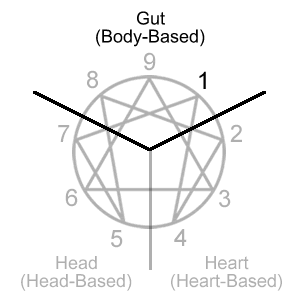
Type 1 is located in the 891 triad which is often described as the gut or body-based center.
There are several ways to interpret what the gut or body types represent. They may be thought of in terms of sensory-somatic (bodily felt sensation), sensory-motor (physical movement and activity), or instinctual (gut decision making).
This may involve taking action based on one's gut instinct, getting pulled along by the agenda of others, and actively trying to correct what's seen as wrong in the world.
Type 1 is often very task-oriented. There can be a lot of activity around organizing, correcting, and improving what seems out of place or doesn't measure up to standards for how things should be. It's hard not to notice when things are not done properly and there is room for improvement. The impulse is to point out to others what needs to be done or correct things themself. This may also involve montoring one's own behavior and that of others.
Type 1 Anger
The anger triad consists of types 8, 9, and 1. Anger for these types involves the gut or body center. It can be thought of as an energy of will that pushes against obstacles to create movement or resists being pushed.
This may involve pushing through obstacles to get what one wants, stubbornly resisting attempts to be pushed in an undesired direction, and getting people to see what's right and correcting things not done right.
Although from the outside type 1 can sometimes appear angry, anger is not usually recognized by the type 1. Instead it takes on other forms such as irritation and criticality, often directed foremost at the self. It's generally felt internally as an energy in service of getting things right or getting others to see what's right. It can sometimes be expressed externally as self-righteous anger or judgment.
To learn more about Enneagram personality type 1 click here.
Head Type: Type 7
-
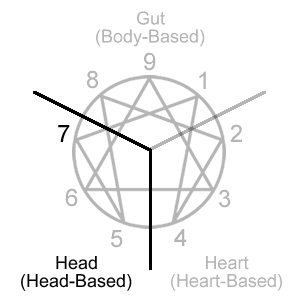
Type 7 is located in the 567 triad which is often described as the head or head-based center.
Although the head types can be thought of in terms of reasoning, analyzing, and other typical thinking functions, a useful distinction from the other two centers can be made in terms of anticipating and preparing for future possibilities.
This may involve gathering data and facts in order to better predict outcomes, preparing for negative potentialities that might occur, and planning or pursuing activities that provide enjoyment and avoid discomfort.
Type 7 avoids pain and limitations while seeking what's interesting and exciting. It's hard to commit to just one thing. Options are kept open because there's always the possibility of an interesting opportunity suddenly presenting itself. When interest in what's going on begins to wane then attention can quickly turn to what's next. There can be a living in the future approach to life where the type 7 wants to always have something exciting to look forward to.
Type 7 Fear
The fear triad consists of types 5, 6, and 7. Fear for these types involves the head center. It can be thought of as a negative anticipation of future possibilities and wanting to prepare for or avoid those possibilities.
This may involve learning as much as possible in order to feel competent and knowledgeable, imagining worst-case scenarios and preparing for them, and having alternatives available to avoid being trapped in discomfort or pain.
Type 7 has a fear of pain, boredom, and limitation. The future is anticipated and choices are made that avoid the negative and pursue the positive. Often when a choice has the possibility of going down a path that leads to what's feared, they'll quickly choose another path or distraction that avoids it.
To learn more about Enneagram personality type 7 click here.
3-1-7 Tri-Center Focus
-

Striving-Correcting-AnticipatingThe tri-center focus looks at your dominant type in each center through the core focus.
-
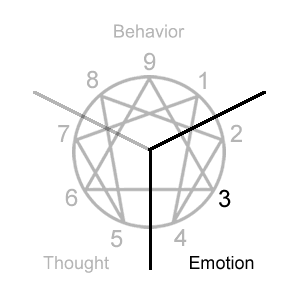
Type 3 Initial Self-Belief: “I am not valued as I am.”
Type 3 Compensation: "I must become accomplished and prove myself to gain value and regard in the eyes of others."
Type 3 Core Focus: Esteem comes from being valued and having the positive regard of others. This requires that I not only package myself and perform in ways that will garner that recognition and positive regard but also find ways of measuring my success toward those ends.
Personality characteristics that might arise from the type 3 core focus:
- Looks to external indicators for how well they're performing.
- Packages and markets self-image that's admired by intended audience.
- Pushes aside feelings that get in the way of achieving goals.
- Sense of self-value comes from what they produce or accomplish.
- Competes in arenas where there is someone to beat and someone to notice.
- Chamelon-like shifts of image occur to match situational expectations.
- Confuses self-presentation with who they truly are.
- Avoids failure by avoiding pursuits where failure is a possibility.
- Gives priority to goals and achieving them over other things.
-
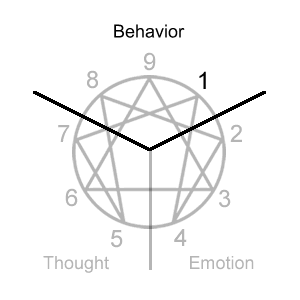
Type 1 Initial Self-Belief: “I am unacceptable as I am.”
Type 1 Compensation: "I must monitor, correct, and improve myself in order to be acceptable and remain above criticism."
Type 1 Core Focus: Acceptability comes from doing things right and acting appropriately according to internalized standards for what that is. This requires I discern what’s right and monitor, correct, and improve my behavior so I don’t fall short of these standards. Others should do the same.
Personality characteristics that might arise from the type 1 core focus:
- Monitors and corrects self-behavior by way of an Inner Critic
- Avoids making mistakes that can be criticized by others
- Compares the world to standards for how things should be
- Tends to look for one right way of doing things
- Strives toward an ideal of perfection
- Attention goes to what needs to be corrected or improved
- Critical of others when they disregard implied rules of behavior
- Tries to be good by modeling appropriate behavior
- Feels responsible for getting things right
-
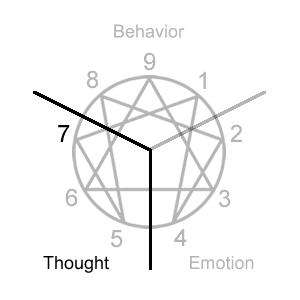
Type 7 Initial Self-Belief: “I am not satisfied as I am.”
Type 7 Compensation: "I must stay open to exciting possibilities that may become available in life and avoid limitations on my pursuits."
Type 7 Core Focus: Enthusiasm comes from possibilities that lead to something interesting, exciting, or satisfying. This requires that I anticipate whether a path might lead to something positive or negative. The positives are pursued while the negatives are avoided, reframed, or escaped from.
Personality characteristics that might arise from the type 7 core focus:
- Likes to keep options open for fear of missing out in life
- Escapes pain and boredom by quickly moving on to something else
- Avoids commitments/obligations that feel limiting and restrictive
- Equalizes relationships with authority to avoid being limited by them
- Attempts to lighten up situations when they become too serious
- Mind quickly jumps between possibilities when excited about an idea
- Lives in anticpation of fun and exciting future possibilities
- Difficulties following through to completion on projects
- Skates on the surface of feelings for fear of getting stuck in them
Heart Focus: Emotional Ambition
Type 3 - Esteem through Emotional Ambition
Gut Focus: Behavioral Correctness
Type 1 - Acceptability through Behavioral Correctness
Head Focus: Mental Possibility
Type 7 - Enthusiasm through Mental Possibility
To learn more about the centers and your center types click on a link below.
Enneagram Tests to Help Determine Centers

The Enneagram personality types group the nine types into three centers of intelligence often referred to as the gut, heart, and head centers.
These tests help you find your dominant type in each center and the order of preference for those centers.
-
Dominant Type in Each Center with Wings Test
This test determines your dominant type in each center (aka tri-center, trifix, tritype, truetype) along with the wings of those types.
Use when you want to know your tri-center or tri-center with wings. -
Enneagram Type Preference Test
This test produces a scored list of all nine types.
Questions are forced-choice, similar to the method used by the Riso-Hudson Enneagram Type Indictor (RHETI).
Use to determine type, wings, gut/heart/head types, and tri-center. -
Center Type Comparison Test
This test scores the three types in a given center to determine your dominant type within that center (gut, heart, or head type).
Use when you don't know your dominant type for one of the centers. -
Type Comparison Test
This test compares any two types, producing a score for each.
Use when unsure of your tri-center order or which of two types is preferred for a center.
Click here for the Complete Guide to the Enneagram.
This free guide explains- the nine Enneagram personality types
- the many type variations within type
- where the types came from (origins and history)
- how the types use the Enneagram symbol
Click here for Enneagram tests.
These free tests help you find your- primary type
- candidate types
- preferred wing
- intinctual subtype
- instinctual variant stacking
- center types (gut, heart, and head)
- tri-center with wings